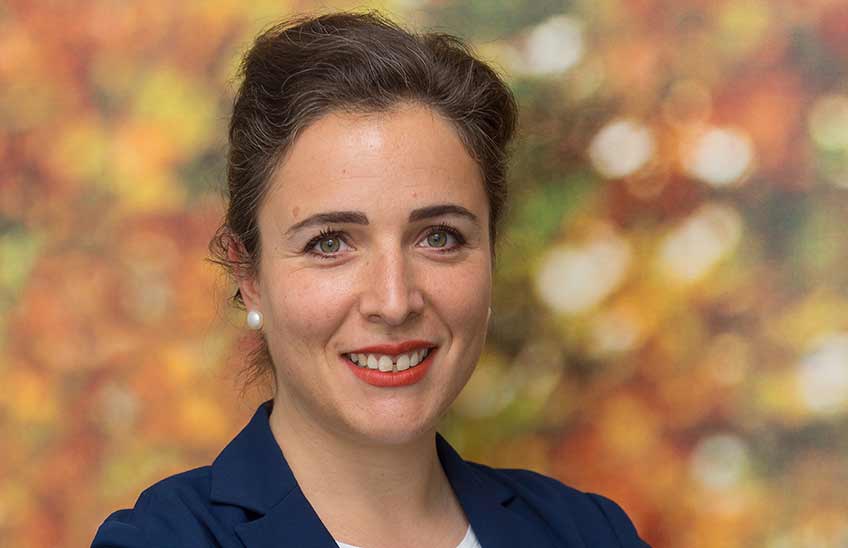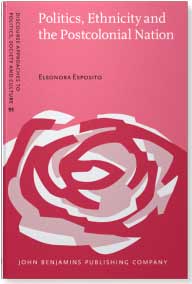Eleonora Esposito: "Narratives in politics help explain the success of populists in Europe and the Caribbean".
A book from Institute for Culture and Society analyzes the speech political in the Caribbean through a novel political campaign in Trinidad and Tobago.

FotoManuelCastells/
Eleonora Esposito expert in critical and multimodal analysis of speech of the Institute for Culture and Society
22 | 06 | 2021
Eleonora Esposito, researcher at group 'Public discourse' of the Institute for Culture and Society (ICS) at the University of Navarra presents on Wednesday, June 23, 2021, her latest book 'Politics, Ethnicity and the Postcolonial Nation. A critical analysis of political discourse in the Caribbean', edited by John Benjamins Publishing Company. This Issue seeks to understand how politics, ethnicity and gender function in the postcolonial Caribbean, specifically in Trinidad and Tobago. To this end, it analyzes Kamla Persad-Bissessar 's political campaign during the 2010 Trinidad and Tobago presidential election from a critical discursive and multimodal point of view.
 This publication is one of the first to apply this methodology of critical and multimodal analysis of speech to the Caribbean context by analyzing discourses that are not literary. Esposito regrets that the Caribbean region has hardly been the subject of scientific research from a critical and discursive point of view. This book offers an updated picture of the power games in a region marked by postcolonialism and with a great ethnic and cultural diversity.
This publication is one of the first to apply this methodology of critical and multimodal analysis of speech to the Caribbean context by analyzing discourses that are not literary. Esposito regrets that the Caribbean region has hardly been the subject of scientific research from a critical and discursive point of view. This book offers an updated picture of the power games in a region marked by postcolonialism and with a great ethnic and cultural diversity.
Why did you investigate this particular political campaign?
What Kamla Persad-Bissessar did was very innovative and smart politically. She put forward a coalition of African parties and Indian parties to win the election. She was also the first Indian woman prime ministerial candidate. It was also a very effective and interesting campaign because of the way they reflected on the country and how they wanted to improve it - something that happens in all political campaigns. There is a lot of imagination of what the future can be like, what they want to change and what values they want to maintain.
Trinidad and Tobago is a very diverse country, what is the importance of ethnicity in politics?
There are two majority ethnic groups: those of African origin, descendants of slaves, and those of Indian origin, who arrived as day laborers to work precariously on the coffee, sugar and cocoa plantations after the abolition of slavery in 1834. There are no Indians in all Caribbean countries, which is why Trinidad and Tobago is so interesting: it is a pluralistic society with two majority groups that live together but do not mix at all. From a political point of view, there are parties that continue to represent these two main ethnic groups.
When the British left Trinidad in 1962, the country gained its independence and was left with a European-style government. In this context, it was difficult to guarantee the representation of all ethnic groups and Africans ended up prevailing in power for more than 30 years until the arrival of Persad-Bissessar.
Is this colonial past reflected in Persad-Bissessar's speech ?
This campaign is interesting for the way in which the history of colonialism was discussed. Persad-Bissessar sample a clear awareness of the need for colonial history to be rewritten from a postcolonial perspective, to challenge the historiography of the British Empire. In particular, she places a strong emphasis on the active role of the resistance of African slaves and Indian laborers in the abolition of both colonial systems of work, as well as in achieving independence. The candidate creates a shared narrative of resistance, knowing full well that this has important implications for political legitimacy and interethnic relations today.
In addition to the speeches, what other elements have you analyzed?
The role of images is also very important in the campaign, which is why it is a multimodal analysis. I have analyzed, above all, videos and promotional images, portraits... All the elements that are part of contemporary political communication, in general, have a lot to do with emotions and with the representation of subjects: who they represent and how they are represented. The image is a moment that can summarize many words and, in politics, it is impossible to make an analysis of political communication without treating images and texts in the same way.
"The political speech tries to create a unitary narrative by erasing very many of the country's differences."
What aspects do you analyze in your book?
The book is organized in three chapters according to the three main elements of the electoral campaign. One is called the leader, another is called the party, and the last is called the nation. The first discusses how Persad-Bissessar has presented herself as a leader, being an Indian woman, as well as the importance of gender issues. She claimed to be the mother and grandmother of the nation and proposed a more 'feminine' leadership in the sense of more collaborative, less hierarchical. Her coalition also had many female candidates so she presented herself as the option in which women could play an important role.
The second, investigate how the party has been presented: one of the first successful coalition parties between Africans and Indians. It portrayed itself as the party that was most able to represent the whole country because it was a mixed party for a mixed country. The coalition's campaign also discursively targeted two of the country's main current problems: representative democracy and the need for constitutional reform on the one hand, and corruption and clientelism on the other.
Finally, we study how the nation has been presented. A postcolonial nation, at development, prey to neocolonial political and economic interference with an often crippling effect. A country with a harsh and very divided history of colonialism that, through narratives, Persad-Bissessar has attempted to rewrite in order to imagine a more united future.
What narrative does Kamla Persad-Bissessar use in her campaign?
In the case of Persad-Bissessar in Trinidad and Tobago, the political speech tries to create a unitary and almost univocal narrative by erasing many of the differences that remain in the country. For example, the two ethnic groups continue to live in different geographic regions and often have occupations in different sectors.
The history told by this nationalism seeks to erase the difference between the experience of slavery of Africans and the experience of forced work of the Indians. Until then, it was understood that Africans had arrived first and had paid with slavery, so they were legitimized to rule.
This candidate tried to involve the Indians in this narrative by appealing to the indentureship system. That is, the Indians who went to the colony had a contract of work in exchange for accommodation and a minimum wage, they were not slaves, but the conditions were very precarious. Thus, de Persad-Bissessar put on the same level the contribution of Africans and Indians to the creation of the nation, celebrating diversity in the nation so that it is not an obstacle to national unity, but one of its greatest riches.
In your campaign you focused a lot on this narrative of the history of colonialism, rather than on economic and social measures?
He talked about both. He talked about the country's problems, such as corruption and poverty, but he focused a lot on this image. One of the thesis of the book is that he talked much more about ethnicity than about issues such as social class or poverty.
"We have a more up-to-date picture of how post- and neo-colonial power games work."
In other words, could we say that your political campaign revolves around the speech of nation building and the history of colonialism?
Yes. I find it very interesting that this campaign has been very much celebrated as the triumph over race and ethnicity. However, that was done by continually talking about ethnicity. It remains the real core, the real issue of political representation and social coexistence.
Furthermore, talking about ethnic conflict is a political distraction so as not to address the economic interests of the elites, the class conflicts... We are facing a country at development, with much inequality, with much poverty, with a neocolonial system of dependent capitalism... There are many problematic aspects that have tried to present in a sweetened way, diverting the attention of the electorate towards race equality or gender equality.
What does the success of this campaign tell us about the importance of narratives in politics?
That they are one of the most effective strategies for winning an election. Narratives have a lot to do with emotions rather than reason. They show how we sometimes reason with our stomach rather than our head when it comes to voting. A political campaign can engage us much more from the point of view of emotions and senses than by the concrete objectives to be achieved. This is something that helps to explain the success of populists in Europe and to explain the success of Persad-Bissessar in Trinidad and Tobago.
What does the analysis of the multimodal critical speech contribute to the programs of study of postcolonialism?
This is one of the first books that applies this methodology of critical analysis of speech to the Caribbean context, analyzing discourses that are not literary, but political and media discourses. I think this is very important and one of the major contributions of the book.
The artistic speech has been analyzed at length and the Caribbean is a region that, politically and strategically, matters very little -it is not the Middle East, for example- and has not managed to attract much international attention. I think that, analyzing contemporary discourses -not the novels of the 50s and 60s of the great Caribbean authors, such as V.S. Naipaul or Sam Selvon- we see how it is talked about now in politics, in the media, etc. We have a much more up-to-date and interesting picture of what this region is like today and how these post- and neo-colonial power games work.
And what does studying this region contribute to the theory of critical speech ?
We have discussed for years how Obama spoke, how Trump spoke, Brexit, immigrants... There are very important issues and they are still the issues that most linguists focus on. I was interested in doing something different, exploring different regions, getting involved in the postcolonial programs of study and developing the methodology a bit more in turn.
I believe I have managed to develop the critical analysis of speech as a postcolonial critique. In addition, I have put into discussion the most Eurocentric aspects of the methodology, since it is a European methodology that was born last century with the Frankfurt School, Michel Foucault, critical theory... What happens when it is applied to a non-European context? To quote Audre Lorde: "The master's tools never dismantle the master's house". I have had to approach the topic with great awareness of the dangers of assimilation and reductionism, trying not to repeat colonial gestures of appropriation or create more inequalities in the speech on the Caribbean.




